The Worlds Best Beginners Workout

Fast-track strength and size gains with this smartly designed 3-phase, 12-week starter’s plan
Many folks think just showing up at the gym is half the battle. We disagree. Once inside, you can get overwhelmed by the assortment of equipment and the million ways you can put together a routine. Just showing up doesn’t guarantee any degree of success whatsoever. That’s because muscle growth isn’t random; just putting in the effort doesn’t assure a more muscular physique.
Any number of choices in the gym can fast-track growth or leave you spinning your wheels without much appreciable gains. Nothing sinks motivation faster than a lack of progress, which is one reason why so many beginners quit.
So let’s put together what you need to know when it comes to your actual workout, and we’ll explain these things so you’ll better understand their critical roles in improving your physique and physical fitness. The three four-week training programs at the end incorporate all the major points discussed here and in the previous article so you can graduate to intermediate status as soon as possible.
1. Focus on All the Major Muscle Groups
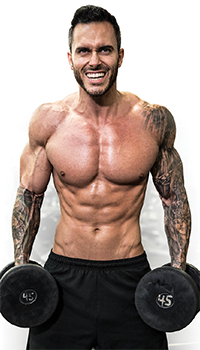
Many of us are initially motivated to focus on building a bigger chest and arms to impress others, but over time that strategy can lead to some serious muscular imbalances, most especially putting your joints at risk of injury and leading to an embarrassing degree of poor symmetry. That’s why it’s important to work all the major muscle groups. Maintaining a balanced strength ratio for opposing muscle groups around a joint—say, the biceps and triceps, which help better stabilize the elbow—is the best way to protect against injuries. Upper-body muscle groups include the chest, back, shoulders, biceps, and triceps; for the lower body, the list includes the glutes, quadriceps, and hamstrings. The abs, calves, and forearms are considered smaller muscle groups. Remember, a muscle group can consist of multiple smaller muscles or muscles with multiple heads.
2. Practice Makes Perfect

Each muscle group requires you to complete basic movements patterns that are likely new to you; for example, with chest you can do presses and flye motions. They require coordination and lots of rehearsal to learn perfect technique. If you don’t get the form down pat, you’ll keep repeating bad form, which at best takes the stress off the intended muscle group and at worst predisposes you to greater risk of injury. Study exercises you see in books and online and aim to duplicate the correct movement patterns, or invest in a qualified personal trainer who can help you correct form deficiencies. Don’t worry about the weights you’re using at this stage; keep practicing and rehearsing the movement pattern until it becomes second nature.
3. Optimize Training Variables for Muscle Growth

If you read the previous article, you’re aware of the five training variables scientists have linked to muscle growth by most positively affecting anabolism—that is, the release of endogenous anabolic hormones. Let’s review here quickly.
Multi-joint exercises. Movements that are multi-joint in nature—two (or more) sets of joints are working in tandem to accomplish the lift—engage more muscle mass, allow you to lift heavier loads, and thus create a greater anabolic stimulus than single-joint ones. This is the single most important factor to remember when choosing what exercises to include in your workout. Front-load multi-joint exercises at the start of your workout when you’re freshest so you can handle the heaviest loads.
Multiple sets. When comparing a single set of an exercise against multiple sets, the latter has consistently been shown to be more effective in making more significant gains in muscle size. The actual number is typically 3 to 4, with beginning-level lifters on the lower end.
Warm-up sets are notgenerally included in the total set count as they’re done with light weight and never taken close to muscle failure. Without a proper warm-up, you not only risk injury but also won’t be able to go as heavy, which becomes more apparent the stronger you become. Most often, sets are arranged in what’s called pyramid fashion: You use progressively heavier weights on succeeding sets as the reps count falls, which also serves to continue the warm-up. Precede that with a five- to 10-minute jog on the treadmill or spin on the bike to start building up a sweat
Ideal working weight. Choosing the “right” working weight is a common question because you can lift a heavy weight just a few times and a light one dozens of times, but which one is best for building muscle? For maximizing hypertrophy, the answer is one with which you can do just 6 to 12 reps with good form. The last few reps should be very challenging. If you can do more than 12 reps, the weight is too light; conversely if you can’t reach even 6, the weight’s too heavy and should be adjusted on your next set. Strength trainers go even heavier for just a few reps. Whatever your goal, remember to never sacrifice form to attempt a weight that’s too heavy.
During Phase 1 of the beginner’s workout below, you’ll actually be using a fairly light weight, one that you can do for about 15 reps (falling a rep or two short of muscle failure). That’s because your initial focus should be on developing coordination and learning the movement pattern using good form, not pushing yourself as hard as possible. Once you’ve nailed the form, you’ll start to increase the load.
Rest periods. As youbegin a set, biochemical changes occur in the muscle fibres that cause fatigue and ultimately failure, meaning that you won’t be able to do another rep on your own with good form. The rest interval between sets allows you to clear built-up lactate and hydrogen ions so you’re ready to go again. Practically speaking, that’s about 60 to 90 seconds, though larger body parts such as legs and back may take longer, especially on the heaviest sets. You want to be mostly recovered by your next set, but you don’t want to be completely recovered because cumulative fatigue over the course of your workout is linked to hypertrophy.
Training to failure. Taking your working sets to a point at which you can’t complete another rep with good form is linked to greater muscle growth. Sure, you can stop beforehand when it starts to get uncomfortable, but that approach will limit overall gains. During the second phase, you’ll start to take your sets to failure. Remember, combined with your rep target, you want that point of failure to be within the 6- to 12-rep range. If you fail outside that rep range, adjust the weight accordingly on the next set.
4. Train at Different Angles to Add Volume

During the first phase of this 12-week plan, you’ll do just one exercise for each major muscle group; during the second month, that doubles to two (and in the third month, three). That, in essence, means you’re increasing the training volume, which is another factor linked to hypertrophy. In adding a second and third movement, pick ones that hit the target muscle group from different angles, such as doing incline presses in addition to flat benches for chest. That more thoroughly works the target muscle, stimulating more complete overall development. Learning how changes in body, bench, foot, and/or arm position affect a given body part is something that you’ll want to learn over time.
5. Control the Rep

Most of us focus on liftingthe weight, but in actuality, each rep has four components: the lift (the positive or concentric rep when the muscle is shortening), the peak-contacted position at the end of the range of motion, the eccentric (negative) rep during which the weight is lowered and the muscle is stretched, and the bottom of the range of motion in which you smoothly reverse direction without bouncing or using momentum.
Training protocols can focus on various aspects of each rep, but as a beginner, your focus should be on lifting the weight in a strong and forceful manner and lowering it under controlin a deliberate fashion, taking about twice as long as the concentric. Be aware that for maximum muscle growth you want to work through the target muscle’s fullrange of motion, which can easily be shortchanged if you’re not paying attention.
6. Breathe Properly

Exhaling as you lift a weight is the recommended way to breathe, and that approach will suit you just fine as a beginner. (Inhale as you lower it.) But as you begin to push heavier loads, you want your torso as stable as possible, and you achieve that by holdingyour breath as you push, which stabilizes intra-abdominal pressure, which simply allows your core to be as strong as possible. If you’re breathing out as you push, you lose that stability as your chest cavity is collapsing. Here, you’ll hold your breath on the exertion until the very top of the lift and then exhale forcefully.
7. Do a Little More Each Workout
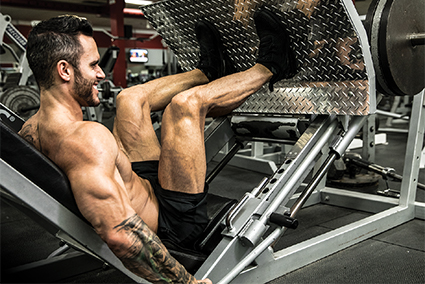
Your body responds to the training stimulus by growing bigger and stronger, at least under optimal conditions. That once-heavy weight from a few weeks ago now seems manageable. But if you do the same exercise again with the same weight for the same number of sets and reps, your body isn’t going to grow any further. Hence, as you get stronger, you need to continually increase the overload, which is most often done by increasing the weight or increasing the number of reps you can do with a given load, to continue making gains. The concept is called progressive overload. Keep it in mind to keep making long-term gains with minimal stagnation.
The 12-Week Beginner’s Plan

Phase 2 (Weeks 5–8)
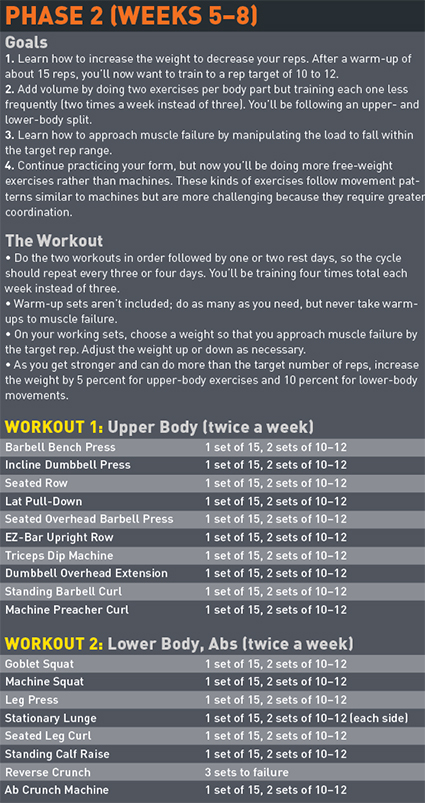
Phase 3 (Weeks 9–12)
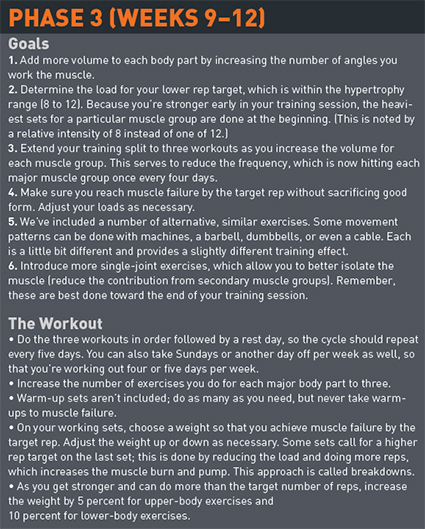
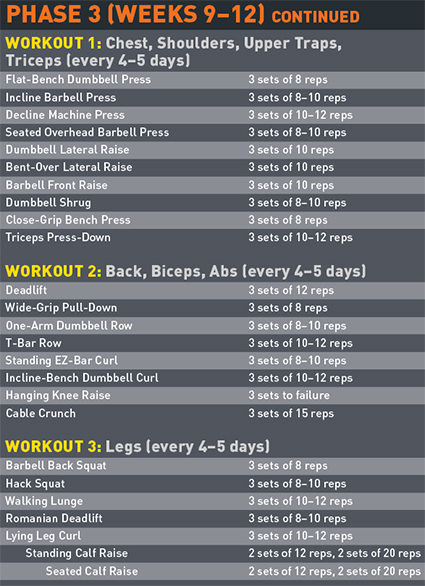
Get articles like this one delivered to your email each month by signing up for Muscle Insider’s mailing list. Just click here.

